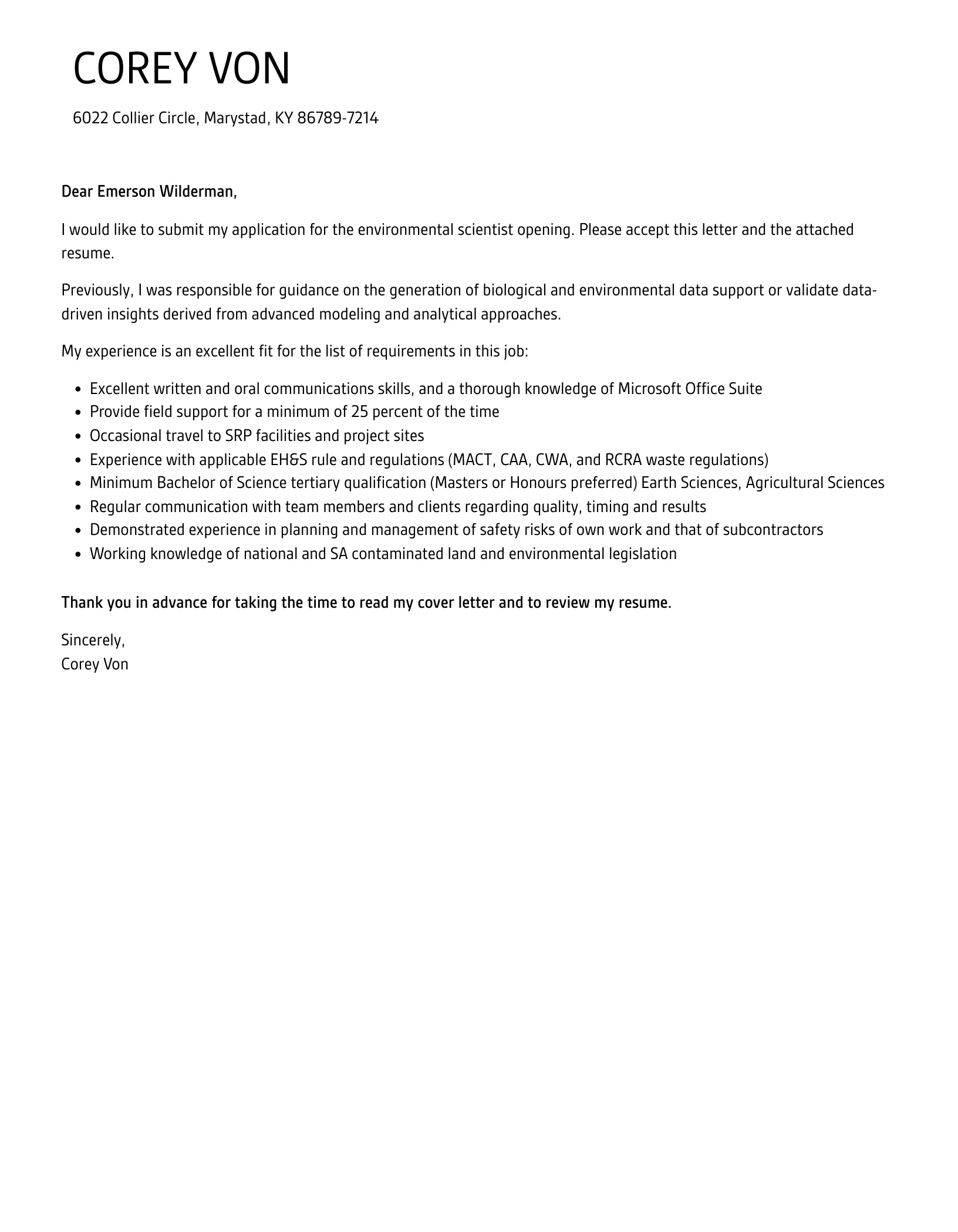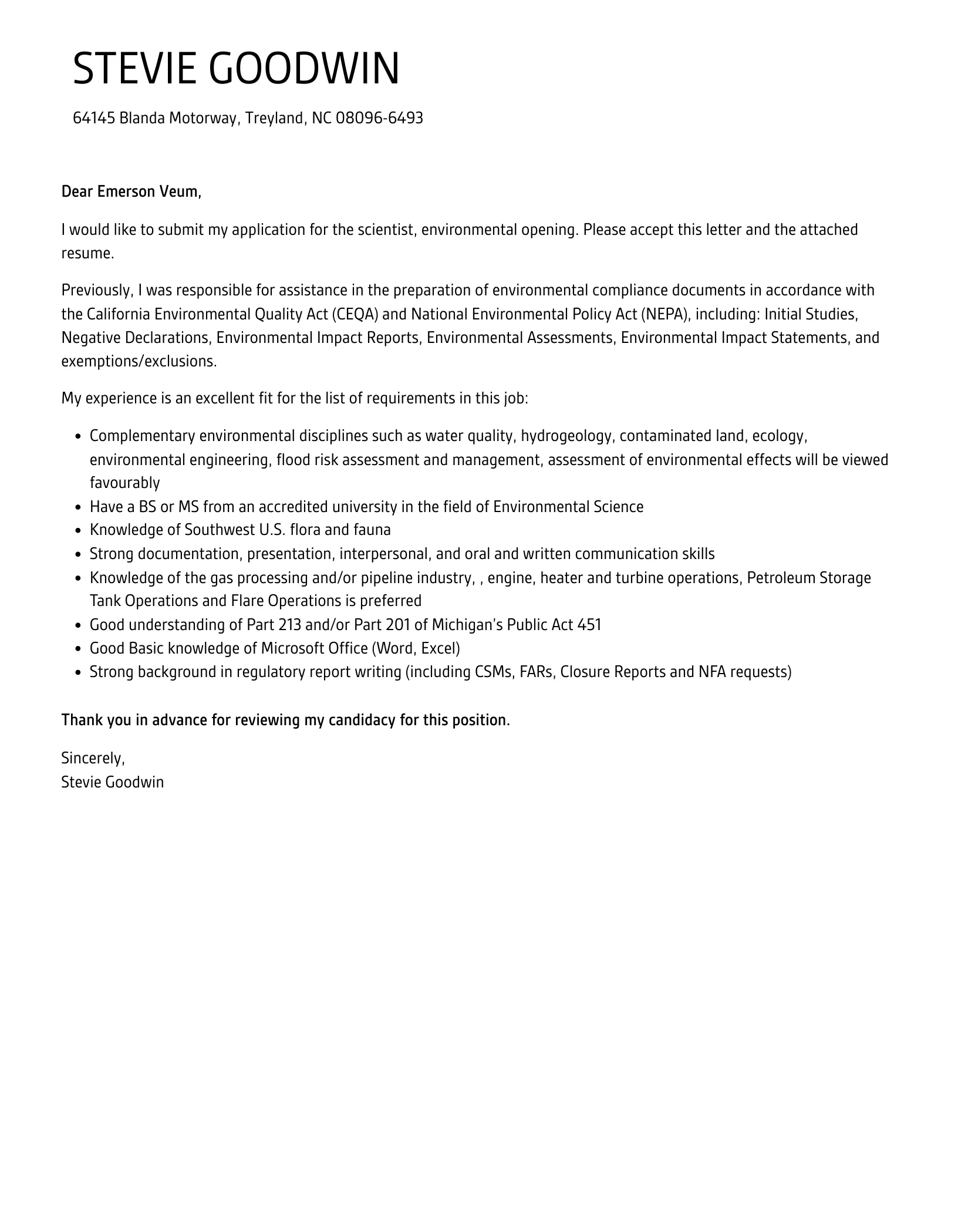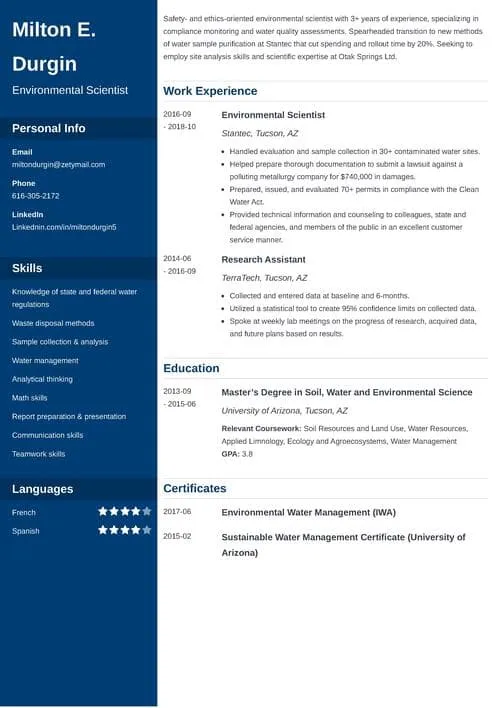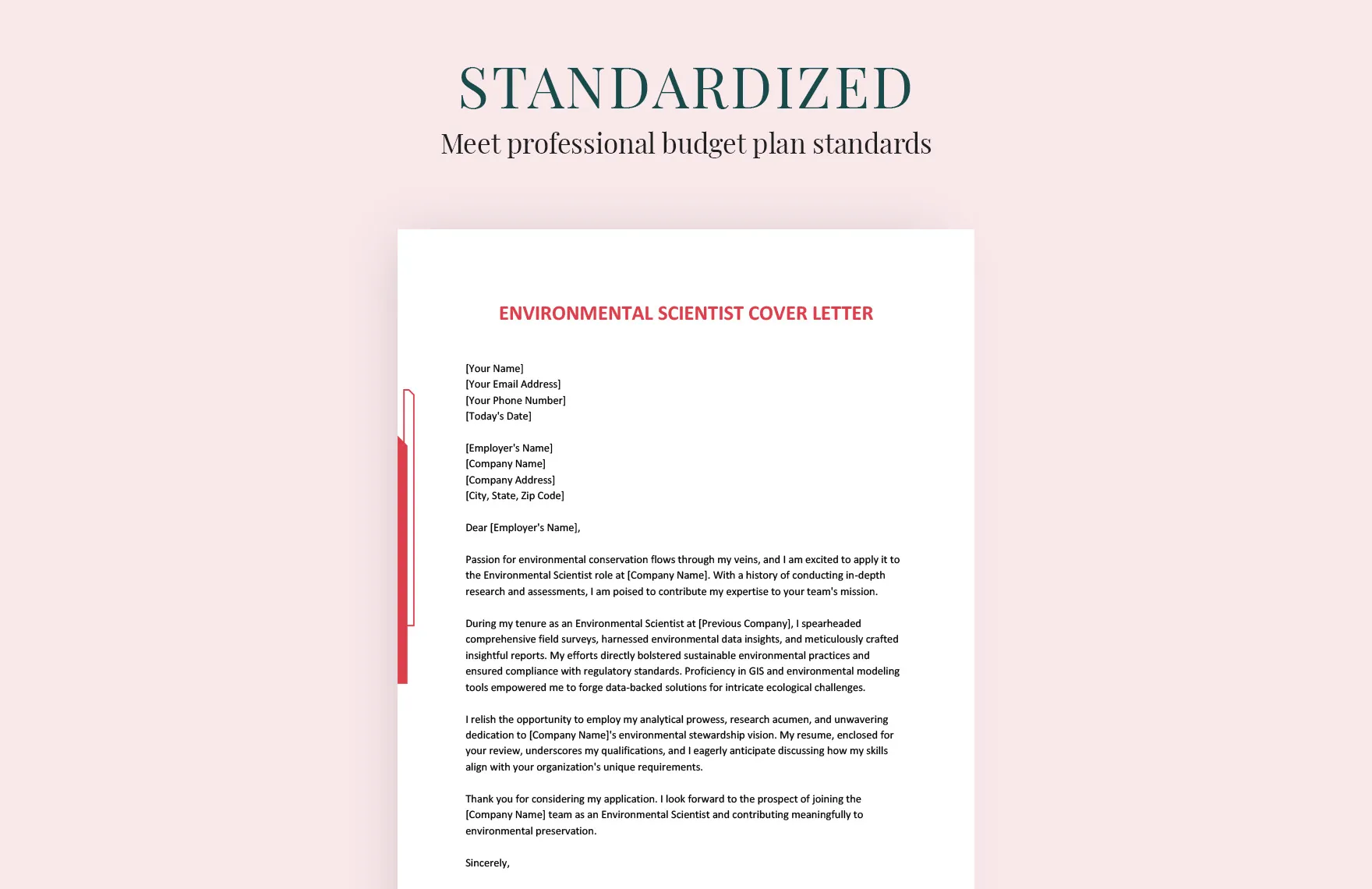What is a Cover Letter and Why Is It Important?
A cover letter is a crucial document that accompanies your resume when applying for a job. It serves as your initial introduction to a potential employer, providing an opportunity to showcase your personality, skills, and enthusiasm for the position. Unlike a resume, which offers a factual overview of your experience and qualifications, a cover letter allows you to tell a story, explaining why you are the perfect fit for the specific role and the organization. It highlights your relevant skills, experiences, and how they align with the company’s needs and goals. An effective cover letter can significantly increase your chances of getting noticed and securing an interview, setting you apart from other applicants. Moreover, it shows your communication skills, writing ability, and attention to detail, all of which are essential in the field of environmental science. Remember, a well-crafted cover letter is your first chance to make a strong impression, so it’s an opportunity you cannot afford to miss. Use it to convey your passion for environmental science and your understanding of the company’s mission, which significantly boosts your prospects. In addition, a great cover letter gives you the chance to address specific requirements or concerns that the employer might have.
Cover Letter Structure for Environmental Scientists
A well-structured cover letter is essential for making a positive impression. The standard structure includes a header, salutation, opening paragraph, body paragraphs (highlighting skills and experience, and quantifying achievements), a closing paragraph with a call to action, and a professional closing. Each section serves a specific purpose in conveying your qualifications and enthusiasm. The header should include your contact information and the date, while the salutation addresses the hiring manager or the specific person mentioned in the job description. The opening paragraph should capture the reader’s attention and state the position you’re applying for. The body paragraphs should then highlight your relevant skills and experience. After this, quantify your achievements with measurable results. The closing paragraph should reiterate your interest and include a call to action, such as requesting an interview. Finally, the professional closing, such as “Sincerely” or “Best regards,” followed by your name, completes the letter. Following a structured format demonstrates your organizational skills and professionalism, increasing your chances of a positive outcome. An easy-to-read, properly formatted cover letter is more likely to engage the reader. This structure also makes it easy for hiring managers to find the information they need quickly.
Header Details

The header of your cover letter is the first thing the hiring manager sees, so it’s important to get it right. Begin with your full name, address, phone number, and professional email address. Ensure that your email address is professional and appropriate. Below your contact information, include the date. Then, align this information to the left or right, depending on your preferred style, but maintain consistency throughout the document. This section provides essential contact details, making it easy for the employer to reach you. Accuracy is key here; double-check all information to avoid any errors. In addition to your contact information, you can include the name and title of the hiring manager if you know it, or you can leave it blank and simply address it to “Hiring Manager.” A well-formatted header shows attention to detail and professionalism. A clean and well-organized header sets a positive tone for the rest of the cover letter. Furthermore, ensuring your contact information is correct guarantees that you won’t miss out on a potential opportunity.
Salutation
The salutation sets the tone for the rest of your cover letter. Aim to address the hiring manager by name whenever possible. This shows that you have done your research and are personally invested in the position. If you can’t find the hiring manager’s name, use a general greeting such as “Dear Hiring Manager.” Avoid generic salutations like “To Whom It May Concern,” as they come across as impersonal. If the job posting provides a specific contact person, address them by name. When addressing someone by name, make sure to spell it correctly, and use their correct title (e.g., Dr., Ms., Mr.). This personalized approach demonstrates your effort and attention to detail, making your application more memorable. Always keep in mind that a well-crafted salutation immediately establishes a professional and respectful tone, setting the stage for a compelling cover letter. Addressing the hiring manager by name helps create a connection and shows that you’ve taken the time to learn about the company and the role.
Opening Paragraph
Your opening paragraph is your chance to grab the reader’s attention. Start by stating the specific position you are applying for and where you found the job posting. Immediately express your enthusiasm for the role and the company. Briefly mention your key qualifications and how they align with the job requirements. This section should be concise and engaging, setting the stage for the rest of the letter. Highlight your interest in the organization and the specific opportunity. This shows that you understand the job and are genuinely interested in the role. Avoid generic opening statements; instead, try to personalize your introduction. Explain why you are excited about this particular position and what you hope to achieve. Mention a specific project or aspect of the company that excites you. This makes your opening paragraph more memorable. The opening paragraph should be compelling enough to encourage the reader to continue reading.
Highlighting Your Skills and Experience

In the body of your cover letter, focus on highlighting your relevant skills and experience. Tailor this section to match the specific requirements outlined in the job description. Instead of simply listing your responsibilities, explain how your skills and experience have led to measurable results in past roles. Use specific examples to illustrate your capabilities, such as completed projects, specific contributions, and successful outcomes. For example, if the job description requires experience in environmental sampling, provide details about your experience, including the methodologies used, the scope of the projects, and the results you achieved. Use action verbs to describe your accomplishments, such as “managed,” “analyzed,” “developed,” and “implemented.” Emphasize how your skills and experience align with the company’s needs and goals. By directly addressing the requirements of the job description, you show that you understand the position and have the qualifications to succeed. Your goal is to convince the hiring manager that your skills and experience make you the ideal candidate.
Quantifying Achievements
Quantifying your achievements is a powerful way to demonstrate your value. Instead of simply stating what you did in previous roles, provide specific, measurable results. This makes your accomplishments more credible and shows the impact you have made. Whenever possible, use numbers to illustrate your successes. For example, instead of saying “Improved data analysis,” state “Improved data analysis efficiency by 25% through the implementation of a new software.” Describe how you saved the company money, reduced environmental impact, or improved project outcomes. Provide evidence of your skills and their effectiveness. For example, if you’ve led a successful environmental remediation project, mention the cost savings or the specific environmental improvements achieved. Provide context for each achievement. Briefly explain the situation, the action you took, and the positive outcome. Use metrics like percentages, dollar amounts, or other quantifiable data to demonstrate your impact. This will help the hiring manager easily grasp the value you bring to the table.
Tailoring Your Cover Letter to the Job Description
Tailoring your cover letter to each job application is critical. Generic cover letters do not show your interest or ability to meet specific needs. Carefully review the job description and identify the key requirements, skills, and qualifications. Then, customize your cover letter to address these points directly. Use keywords from the job description throughout your letter to show that you understand the role and the employer’s needs. Give examples of how your skills and experience match the job requirements. Highlight your relevant experience and focus on the skills and qualifications that align with the specific position. Demonstrate that you have the skills and expertise required by the role. Explain why you are interested in this specific position and the company, not just any job. Research the company to understand its mission, values, and recent projects. Mention specific projects or aspects of the company that align with your interests and skills. This customization makes your cover letter more relevant and demonstrates your genuine interest, increasing your chances of securing an interview.
Closing Paragraph

Your closing paragraph should reiterate your interest in the position and the company. Briefly summarize why you are a good fit and what you can offer. Reiterate your enthusiasm and emphasize your key qualifications. Thank the hiring manager for their time and consideration. Express your eagerness to discuss your qualifications further. Use a confident and professional tone. Clearly state your interest in the position and thank the hiring manager for considering your application. Keep the closing paragraph concise and focused, summarizing your key qualifications and restating your enthusiasm for the position. This final impression can reinforce your strengths and reinforce your desire to work for the company. A well-crafted closing ensures that your application leaves a lasting positive impression, potentially leading to an interview.
Call to Action
Include a clear call to action in your closing paragraph. This tells the hiring manager what you want them to do next. You should explicitly request an interview. State that you are available for an interview and provide your contact information again. Mention that you are eager to discuss your qualifications in more detail. For example, you could say, “I am eager to discuss my qualifications further and am available for an interview at your earliest convenience.” This clear call to action encourages the hiring manager to take the next step, increasing your chances of moving forward in the application process. Make it easy for the hiring manager to contact you and schedule an interview. Reinforce your interest in the position and make sure they know how to reach you. This direct approach makes it easier for the hiring manager to take action and keeps your application moving forward.
Formatting and Proofreading
Proper formatting and thorough proofreading are essential for a professional cover letter. Use a clear, easy-to-read font such as Times New Roman, Arial, or Calibri. Ensure that your font size is between 10 and 12 points and that your paragraphs are well-spaced. Maintain consistent formatting throughout your letter, including the use of bolding, italics, and bullet points (if necessary). Proofread your cover letter multiple times for any grammatical errors, spelling mistakes, and punctuation issues. Have someone else review your cover letter to catch any errors you may have missed. Ensure your cover letter is free of typos and errors. Proofreading is a key step in making sure your cover letter is of the highest quality. Double-check all contact information, dates, and names. Ensure your cover letter looks clean and professional to leave a positive impression. Well-formatted and error-free documents demonstrate attention to detail, which is crucial in the environmental science field. Good formatting increases readability.
Common Mistakes to Avoid in Your Cover Letter

Several common mistakes can undermine your cover letter. Avoid generic or vague statements, such as “I am a hard worker.” Instead, provide specific examples of your accomplishments and skills. Do not simply repeat your resume; instead, expand on your experiences and tailor your letter to the specific job. Refrain from using jargon or overly complex language. Aim for clarity and simplicity to ensure that the hiring manager can easily understand your message. Avoid typos, grammatical errors, and spelling mistakes, as these can create a negative impression. Do not provide excessive or irrelevant information; focus on the skills and experiences relevant to the job. Make sure your tone is professional and enthusiastic, and avoid sounding arrogant or entitled. Always tailor your letter to each job application; sending the same letter to multiple companies is a major turnoff. By avoiding these common mistakes, you can significantly increase the effectiveness of your cover letter and improve your chances of landing an interview. A polished cover letter shows that you are a professional, and attention to detail is important in environmental science.
